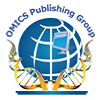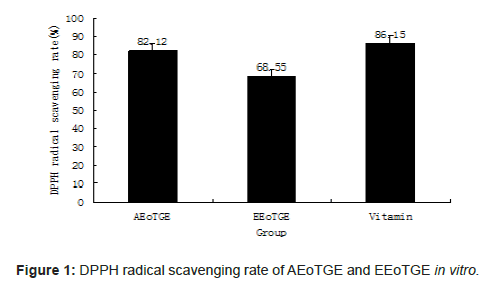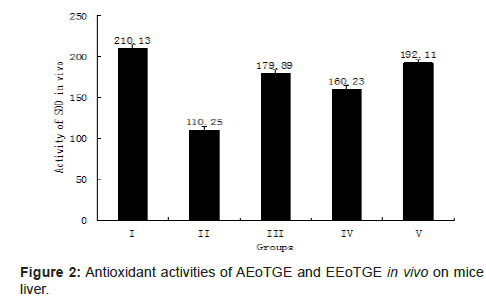Research Article Open Access
Study on Antioxidant Activity of Typhonium giganteum Engl. Tuber Extracts in vitro and in vivo
Yanling Song*, Weize Bao, Baina Li, Guang Yang and Zhiwei PangDepartment of Pharmaceutical Engineering, Shenyang University of Chemical Technology, Liaoning, 110042, P.R., China
- Corresponding Author:
- Yanling Song
Department of Pharmaceutical Engineering
Shenyang University of Chemical Technology
Liaoning, 110042, P.R., China
Tel: +86-13840387750
Fax: +86-24-89383622
E-mail: yanlingsong521@126.com
Received date August 17, 2013; Accepted date September 16, 2013; Published date September 20, 2013
Citation: Song Y, Bao W,Li B,Yang G,Pang Z(2013) Study on Antioxidant Activity of Typhonium giganteum Engl. Tuber Extracts in vitro and in vivo. J Biomim Biomater Tissue Eng 18:112. doi:10.4172/1662-100X.1000112
Copyright: © 2013 Song Y, et al. This is an open-access article distributed under the terms of the Creative Commons Attribution License, which permits unrestricted use, distribution, and reproduction in any medium, provided the original author and source are credited.
Visit for more related articles at Journal of Biomimetics Biomaterials and Tissue Engineering
Abstract
To study the antioxidant effect of the aqueous extracts of Typhonium giganteum Engl. tuber (AEoTGE) and ethanol extracts of Typhonium giganteum Engl. tuber (EEoTGE) in vitro and in vivo, which may be the possible mechanism of its bioactivity efficacy. The antioxidant activity in vitro was evaluated by 1, 1-diphenyl-2-picryl-hydrazyl (DPPH) radical scavenging rate with Vitamin C as a positive control. The antioxidant activity in vivo was carried out to investigate the effects of AEoTGE and EEoTGE on D-galactose caused aging model mice by determining liver tissues’ superoxide dismutase (SOD) activities. The results indicated that AEoTGE and EEoTGE have good antioxidant activity in vivo and vitro. The antioxidant effect of AEoTGE is better than that of EEoTGE.
Keywords
Typhonium giganteum Engl.; Antioxidant; Bioactivity
Introduction
Typhonium giganteum Engl. belongs to the family Araceae, which is a Chinese endemic plant. The dried root tuber of which has been used as a Chinese traditional medicine (Baifuzi) recorded in Chinese Pharmacopoeia [1]. Typhonium giganteum Engl. has many chemical constituents including glycosides, amino acids, proteins, sterols, sugars, flavonoids, trace elements and other substances [2-8]. Its rich constituents determine its pharmacological effects such as antibacterial, anti-inflammatory and anti-cancer etc [9-11]. With the development of herbal drugs bioactivity mechanism research, it was discovered that the efficacy of herbal medicine is closely related to its antioxidant effects. In this study, the antioxidant activity of Typhonium giganteum Engl. tuber extracts in vitro and in vivo is mainly discussed.
Materials and Reagents
Plants and reagents
Typhonium giganteum Engl. was collected from Tonghua Country, Jilin Province, P.R.China; 1,1-Diphenyl-2-picrylhydrazyl (DHHP) were purchased from Sigma Chemical Co., Ltd.; SOD test kit were bought from Nanjing Jiancheng Bioengineering Institute. All the other reagents were analytical grade.
Experiment animals
Fifty female Kunming mice (20 ± 2 g) were purchased from Laboratory Animal Center of Liaoning University of Traditional Chinese Medicine, certificate number: SCXK 2008-0005.
Methods
Extraction of Typhonium giganteum Engl. tuber
100 g Typhonium giganteum Engl. tuber were washed and dried at 40-45°C. Subsequently, the dried roots were crushed to 20-mesh. 500 ml distilled water or 95% ethanol was added for soaking overnight at room temperature (25 ± 2°C). Heated to reflux for 3 hours and then filtered. The extraction procedure was repeated twice. The aqueous extracts of Typhonium giganteum Engl. tuber (AEoTGE) and ethanol extracts of Typhonium giganteum Engl. tuber (EEoTGE) were combined respectively, concentrated and dried at 60°C in vacuum. At the end, 9.6 g AEoTGE and 8.5 g EEoTGE were obtained and stored at 4°C until used.
Scavenging DPPH radical test in vitro [12]
Accurately weighted 1.97 g DPPH, dissolved in methanol and in 10 mL volumetric flask, DPPH concentration was 0.5 mmoL/mL, which was stored at 4°C and protected from light. 0.5 ml of 0.5 mmoL/mL DPPH solution and 2 mL of 1 mg/mL AEoTGE, EEoTGE or Vitamin C solution were mixed and rest for 30 min at 37°C, the absorbance of solution was measured at 510 nm and the value was recorded as Ai. When using methanol instead of extract, the measured absorbance values were recorded as A0. When using methanol instead of DHHP, the measured absorbance values were recorded as Aj. Then the scavenging rate (%) of sample could be expressed as:
SR= 1- (Ai-Aj)/A0× 100%
Animal grouping and administration
Fifty female Kunming mice were divided into five groups randomly (10 mice/group), including I: negative control group; II: AEoTGE group (1.0 g/kg); III: EEoTGE group (1.0 g/kg); IV: positive control group (Vitamin C, 1.0 g/kg); V: modle group (D-galactose, 1.0 g/ kg). All the Kunming mice were adapted in animal room for 1week before they were administration. Modle group, positive control group, AEoTGE group and EEoTGE group were injected of D-galactose, 1.0 g/ kg on the nape for 42 days to cause aging model. AEoTGE and EEoTGE were dissolved in pure water to make 1.0 g/ml solution. The AEoTGE, EEoTGE and Vitamin C solution were orally administered into mice with the dose of 0.1 ml/10 g body weight, once per day for 15 d using a feeding atraumatic needle. After administration they were sacrificed by cervical dislocation and liver was taken. The liver was given an icebath in 0.9% iced normal saline and made into 10% tissue homogenate, centrifuged at 3500 rpm at 4°C for 20 min, then kept at -20°C for next testing.
Superoxide dismutase (SOD) test in vivo
Superoxide anion (O2-) can promote the oxidation of hydroxylamine into its nitrite forms. Superoxide dismutase (SOD) is a special inhibitor to O2-.The assay for total superoxide dismutases (SOD) was based on its ability to inhibit the oxidation of oxymine by the xanthine-xanthine oxidase system [13]. SOD activity was determined using SOD Assay Kit. The operation was in accordance with the specification requirements of SOD kit.
Statistical analysis
All tests were carried out in 3 times. All data are expressed as s mean ± standard. Statistical analysis was carried out using SPSS software (SPSS, version 10.0). Data were analyzed using by Student’s t-test and were considered to be statistically significant if P ≦ 0.05.
Results and Analysis
DPPH radical scavenging rate in vitro
The results were shown in Figure 1. According to the analysis of t-test, AEoTGE exhibited a similar anti-oxidation activity compared with Vitamin C (P<0.01). The radical scavenging rate of anti-oxidation of AEoTGE is higher than EEoTGE, the difference of them is 13.77%, which meansr that the anti-oxidation activity of AEoTGE is better than EEoTGE.
Activity of SOD in vivo
As shown in Figure 2, compared with the normal group, SOD activities in liver of model group decreased significantly (P<0.01). This suggested that antioxidant capability of organism under D-galactose condition was evidently weakened. It was found the antioxidant activity increased after the administration of AEoTGE (P<0.01), EEoTGE (P<0.01) and Vc (P<0.01) compared with the model group. The result indicated that AEoTGE and EEoTGE could improve SOD activity of mice, and the AEoTGE group is better than EEoTGE group.
Conclusion
In the present study, antioxidants regulate the body metabolism and promote the antioxidant capability of the organism, to further exert other functions and help to cure various diseases [14]. In order to study the possible relationship between antioxidant properties and the other effect such as anti-bacterial, anti-inflammatory and anticancer of Typhonium giganteum Engl., we examined the antioxidative potential of it in vitro and in vivo. Our data demonstrated that AEoTGE have good antioxidant effect compared with Vitamin C in vitro and in vivo. It could be a natural antioxidant eroxidation and its antioxidant activity should make contributions to its other aspect activities.
Financial Support
Supported by Scientific Found of Liaoning Provincial Department of Education General Project (No L2012146), Doctoral Initiating Project of Shenyang University of Chemical Technology (No32006077094) and University student Scientific and technological innovation projects (No 201210149004).
References
- The Pharmacopoeia Commission of P.R. China (2000) The Pharmacopoeia of P.R. China (2000edn.), Chemical Industry Publishing House: Beijing 1: 80.
- Chen XS (2002) Studies on the Chemical Constituents of Two Traditional Chinese Medicines Rhizoma Typhonii & Semen Aesculi and Total Synthesis of Typhonoside A.
- Ai FW, Zhang S, Li YF, et al. (2010) Chemical constituents in root of Typhonium giganteum. Zhongcaoyao 41: 201-203.
- Chen XS, Chen DH, Si JY, Tu GZ (2001) Chemical constituents of Typhonium giganteum Engl. J Asian Nat Prod Res 2001: 277-283.
- Li QY, Jiang CF, Zu YG, Song Z, Zhang BY, et al. (2011) SFE-CO2 extract from Typhonium giganteum Engl. tubers, induces apoptosis in human hepatoma SMMC-7721 cells involvement of a ROS-mediated mitochondrial pathway. Molecules 16: 8228-8243.
- Zhang T, Chen X, Luo Y (2011) GC-MS analysis of volatile oils from fresh and processed Typhonii Rhizoma. Zhongguo Zhongyao Zazhi 36: 1337-1341.
- Liu L, Chen YP, Li J (2003) Amino acid content analysis of the various parts in Typhonium giganteum Engl. Journal of Jilin University (Medicine Edition) 29: 54-55.
- Baojun S, Hongfang J, Botao Z, Weiming Z (2010) Study on Chemical Constituents of Typhonium giganteum. Chinese Wild Plant Resources 29: 38-39.
- Wang SQ, Ni H, Cheng H, Wang GL, Wang TS, et al. (2004) Detection of differentially expressed genes in hepatocellularcarcinoma cells SMMC-7721 treated with Typhonium giganteum extract by mRNA differential display. Zhongguo Zhong Yao Za Zhi 29: 974-978.
- Wang LM, Ye B, ZhenJun Z, ShuYing L (2009) Inhibition of Proliferation and Induction of Apoptosis in MCF-7 Cell by Typhonium Giganteum Engl├ó┬?┬Ł .[J] Journal of Shenyang Agricultural University 40: 174-176.
- Ma YL, Li YF, Tang LP, Ai FW (2010) Study of lignans ofRhizoma Typhonii on the expression of TRAIL and its receptors in gastric carcinoma cell line (SGC7901). Chinese Journal of New Drugs 19: 225-228.
- Gou MY, Liu L, Zhang CZ (2010) Dertermination of antioxdant of activity in 26 plants by DPPH method. Food and fermentation industries 36: 148-150.
- Oyanagui Y (1984) Reevaluation of assay methods and establishment of kit for superoxide dismutase activity. Anal Biochem 142: 290-296.
- Flora SJ (2007) Role of free radicals and antioxidants in health and disease. Cell Mol Biol 53: 1-2.
Relevant Topics
Recommended Journals
Article Tools
Article Usage
- Total views: 22058
- [From(publication date):
November-2013 - Nov 21, 2024] - Breakdown by view type
- HTML page views : 17528
- PDF downloads : 4530


